| Published in Attractions / Places of Interest |
Kinryuzan Senso-ji Temple, Japan
Mahayana Tradition, 7th century CE.
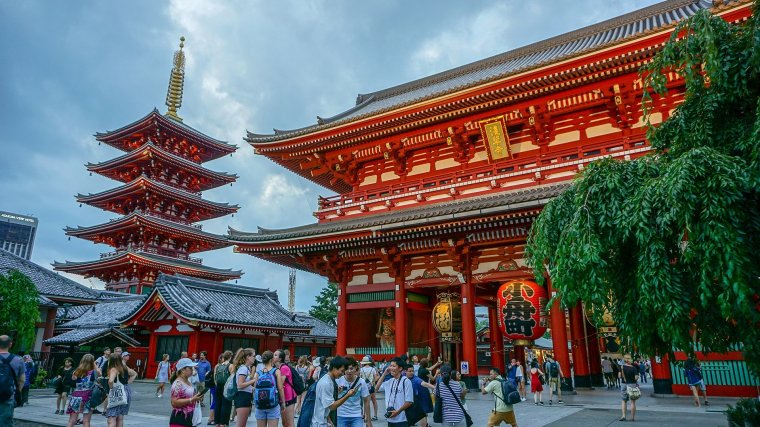
Senso-ji Temple. Photo: jreysp, Wikipedia.
Senso-ji is an ancient Buddhist temple located in Asakusa, Tokyo, Japan, dedicated to Kannon Bosatsu (Avalokiteśvara), the Bodhisattva of compassion.
It is Tokyo's oldest temple and is the most widely visited spiritual site in the world with over 30 million visitors annually.
Location
History
According to legend, a statue of the Kannon was found in the Sumida River in 628CE by two fishermen, brothers Hinokuma Hamanari and Hinokuma Takenari.
The chief of their village, Hajino Nakamoto, recognized the sanctity of the statue and enshrined it by remodeling his own house into a small temple in Asakusa so that the villagers could worship Kannon.
The first temple was built in 645CE, by a Buddhist priest named Shokai, which makes the temple the oldest in Tokyo. Following a revelation received in a dream, Shokai decided to keep the statue hidden from view, and was never unveiled since then.
150 years later, a monk named Ennin, the head priest of the main temple of the Tendai School of Buddhism, visited Senso-ji. He created a statue identical to the main image (absolutely Hibutsu)1 so that, occasionally, it could be shown to the public.
In the early years of the Tokugawa shogunate, Tokugawa Ieyasu2 designated Senso-ji as tutelary temple of the Tokugawa clan.
During World War II, the temple was bombed and destroyed during the 10 March 1945 air raid on Tokyo. It was rebuilt later and is a symbol of rebirth and peace to the Japanese people.
In the courtyard there is a tree that was hit by a bomb in the air raids, and it had regrown in the husk of the old tree and is a similar symbol to the temple itself.
Formerly associated with the Tendai sect of Buddhism, Senso-ji Temple became independent after World War II.
Features
• Main Hall (Kannondo) was built by the 3rd Tokugawa shogun, Tokugawa Iemitsu. The image of the Bodhisattva Kannon is placed in a miniature temple of naijin (inner sanctum).
• Yogodo Hall was dedicated to honor monk Ennin, at the 1200 anniversary of its birth.
• Awashimado Hall was built during the Genroku Period (1688-1704) to enshrine Awashima Myojin.3 The principal image of Amitabha is placed in the middle with Awashima Myojin and Kokuzo Bosatsu (Ākāśagarbha).
• Bentendo Hall houses a statue of Benzaiten.4
• Other remarkable architectural features are: The Five-Storied Pagoda, Demboin and Its Garden, Niten-mon Gate, Hozo-mon Gate, Kaminari-mon Gate and Nakamise Shopping Street.
Yearly Events
• Hatsumode is the First Temple Visit of the Year, January 1-7, when people come to pray for safety, good health, and good harvest.
• Onzahihodarani-e is a praying ritual held from January 12 at 6:00 to January 18 at 18:00. During the total of 168 hours, the chief monks continuously read Buddhist sutras in one hour shifts.
• Setsubun-e (Spring Celebration) happens during first week of February, to celebrate the coming of spring. People throw dried beans to drive out evil and bring in good luck.
• Honzon Jigen-e, celebrates the Appearance of the Bodhisattva Kannon on March 18th.
• Hana Matsuri, or Flower Festival, is the celebration of Buddha’s Birthday, on April 8th.
• Sanja Matsuri, the "Three Shrine Festival", or Sanja Festival, is held in honor of Hinokuma Hamanari, Hinokuma Takenari, and Hajino Nakatomo, the three men who established and founded the Senso-ji temple.
Sanja Matsuri is held on the third weekend of every May at Asakusa Shrine. Its prominent parades revolve around three mikoshi (portable shrines referenced in the festival's name), as well as traditional music and dancing. Over the course of three days, the festival attracts 1.5 to 2 million locals and tourists every year.
• Yojijosuikaji-e and Hyakumikuyo-e are festivities when worshippers pray for good health and express their gratitude to Bodhisattva Kannon and the Buddha.
• Shiman-rokusen-nichi, is celebrated June 9th and 10th, when prayers are considered to be 46000 times more powerful than in any other day.
• Osame-no-Kannon Goennichi is the last festival of the year, held from the 17th to 19th of December.
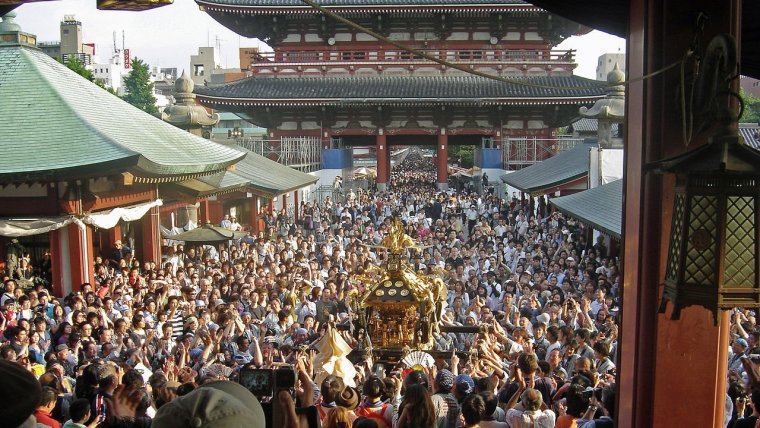
A view of the Hozomon gate and the Nakamise beyond it as well as one of the main mikoshi from the top step of Sensō-ji during Sanja Matsuri. Photo: Torsodog, Wikipedia.
Visiting
Main hall is open 6:00 to 17:00 (from 6:30 from October to March) and temple grounds are always open. Admission is free.
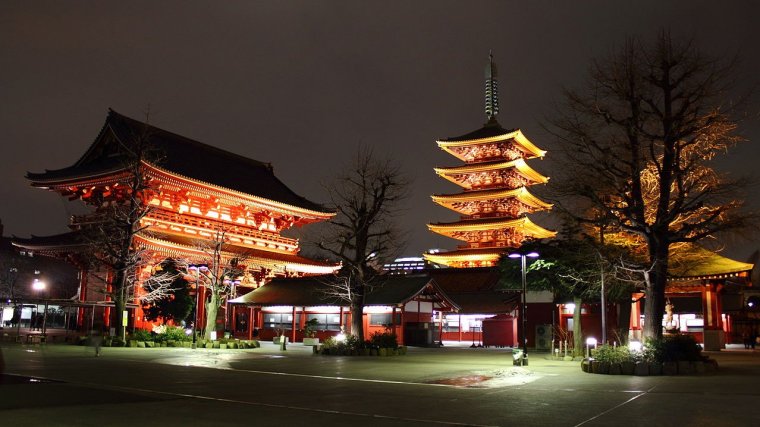
Senso-ji Temple at night. Photo: Kakidai, Wikipedia.
Sources
• https://www.senso-ji.jp/english/
• https://en.wikipedia.org/wiki/Sens%C5%8D-ji
• https://matcha-jp.com/en/955
Footnotes
1. Hibutsu ("hidden Buddhas") are Japanese Buddhist icons or statues concealed from public view. Hibutsu are generally located within Buddhist temples in shrines called zushi ("miniature shrines"). They are generally unavailable for viewing or worship, although they are brought out for specific religious ceremonies; it is also possible in some cases for the hibutsu to be viewed in exchange for an offering to the temple.
Certain hibutsu, such as the wooden statue of Gautama Buddha at Seiryō-ji or the Amida statuary at Zenkō-ji, are almost never displayed, not even to initiates of the temples in which they are held (such examples are known as zettai hibutsu). Others are put on public display only rarely, in a ceremony called kaichō ("opening the curtain").
The concealment of the hibutsu is intended to emphasize their potency and transcendence. It may also serve to protect them from pollution by the impure influences of the mundane world, or to preserve the personal privacy of these "living" embodiments of Buddhism.
It has been noted by art historians such as Shiro Ito that hibutsu are a uniquely Japanese phenomenon; other Buddhist cultures do not have any equivalent practice.
2. Tokugawa Ieyasu (1543-1616) was the founder and first shōgun of the Tokugawa shogunate of Japan, which ruled Japan from 1603 until the Meiji Restoration in 1868. He was one of the three "Great Unifiers" of Japan, along with his former lord Oda Nobunaga and Toyotomi Hideyoshi.
3. Awashima Myojin is a deity that bestows fertility, protects pregnant women, oversees childbirth, and heals ailments of the female reproductive system, including sexually transmitted diseases.
4. Benzaiten (also known as Benten) is a Japanese Buddhist goddess who originated from the Hindu goddess Saraswati. Worship of Benzaiten arrived in Japan during the 6th through 8th centuries, mainly via the Chinese translations of the Sutra of Golden Light, which has a section devoted to her. She is also mentioned in the Lotus Sutra and often depicted holding a biwa, a traditional Japanese lute, just as Saraswati holds a veena.
Benzaiten is a syncretic entity with both a Buddhist and a Shinto aspect. Benzaiten was worshiped as the personification of wisdom in the Tokugawa period.
YOU MAY ALSO LIKE
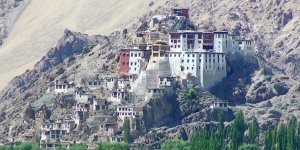
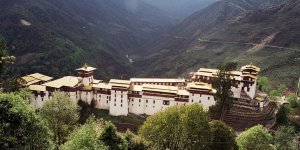

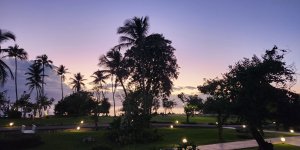


 If you own or manage a travel-related business such as a hotel, a bed-and-breakfast, a restaurant, a pub or a cafeteria, you can create a web page for your business for free on Titi Tudorancea Travel Info. » |